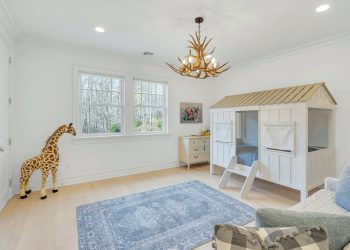RISMEDIA, February 3, 2009-(MCT)-With the economy and housing market in a slump, some growing families are making do with the space they’ve got instead of moving to a bigger home. That means their kids may start doing something that kids don’t do much these days: share a room.
But experts say some simple tricks can make shared bedrooms a happy place where children can express their individuality while fostering tight bonds with their siblings.
“I think it teaches children to be thankful for what they have, and realize you don’t need your own everything” said Laura Brown-Willingham, whose three children, ages 9, 8 and 6, share a room in the family’s 800-square-foot cedar cabin in Davidson, N.C.
Design and organization consultants had lots to say about designing fun, functional rooms for two or more. Traditional bunk beds are great space savers, but look into other bed configurations as well.
Cornelius, N.C.-based interior designer Kelly Cruz is partial to an L-shaped bunk bed configuration that consists of an elevated bed against a wall with a single bed below it extending out at a right angle. The configuration allows half of the space below the elevated bed to be used for storage or a dresser.
Regular loft beds allow room underneath for play space, a desk or a dresser, depending on the child’s needs.
But parents should make sure their children are old enough for bunk beds. Experts say most kids probably aren’t ready until at least 5 or 6.
If the children are a bit older and care about privacy-especially if one is a boy and the other a girl-consider installing draw drapes between their beds, says Charlotte, N.C., interior designer Leslie Williams. Installing the curtains is easy using a track system on the ceiling, Williams says. (Think hospital rooms.) Even a gauzy fabric that allows light to pass through will give the feeling of privacy, she says.
Another way to create a separate zone for each child is to place an open bookcase in the middle of the room as a room divider. Having “yours,” “mine,” and “our” space helps kids feel they have their own piece of a room, Williams says.
Color and Fabric
Kids are bound to have different tastes in colors and patterns, so don’t insist on buying matching comforters. Instead, Williams says, pick an “inspiration fabric” that has colors both children like.
Use the agreed-upon fabric for items like curtains and bed skirts, but have each of them pick a favorite color in the fabric and use it for their bedspreads and other personal room decor items like bulletin boards, lampshades, or dresser and desk accessories.
Pick a paint color or two from the common fabric and keep it simple by painting the room one color. Or, in the case of bunk beds, consider dividing the room horizontally where the top bunk meets the bottom and paint the bottom half of the room one color, the top half the other color.
Keep furniture simple. Don’t overwhelm a crowded room with too many patterns and clutter. “You want to keep it very basic, with neutral main pieces of furniture so the room can be changed as the kids grow,” says Sherrie Le Masurier, a decorating consultant. “Don’t go out and buy a Barbie dresser. Go neutral, and keep your furniture staples really basic. Let the personality come out with the accessories.”
Character-themed sheets or even a lampshade or wastebasket are fine, Le Masurier, says, because they can be cheaply and easily changed when the children move on to other interests. Getting rid of the dollhouse-shaped bookshelves or Dora lamps, however, won’t be quite as easy.
Make your furniture have multiple uses. A bench should have storage space inside. Bedside tables should contain bookshelves or drawers.
Charlotte Observer parenting columnist Betsy Flagler says putting kids in the same room can breed close-knit relationships between siblings.
“Parents don’t need to apologize for having siblings share bedrooms. I think younger children especially prefer cozier homes than huge, rambling houses with a thousand square feet per person,” says Flagler of Davidson.
The Willinghams hadn’t intended such tight quarters, but when dad Christopher lost his job about three years ago, the family moved from a 2,400 square-foot house into the cabin they once leased to renters.
Mom Laura acknowledges that space is tight-she salivates over the prospect of having two bathrooms again-but she says she’ll always opt for a cozy cottage over a cavernous mansion.
Big homes mean “huge upkeep,” she says. “I’d rather have a bigger barn with animals in it than a huge house.”
Togetherness tips:
– Keep it simple. Fewer pieces of furniture and cleaner lines will make a small room seem less crowded.
– If your kids are old enough, bunk or loft beds are a great way to save space.
– Don’t over-“theme” the room. It will get quickly dated and you’ll end up replacing pieces more quickly.
– Get creative with color, even if two kids have opposite tastes.
– For older kids, consider ways to give each child a little privacy.
These websites offer tips on decorating kids’ rooms:
www.bhg.com/decorating/kids-rooms
www.hgtv.com/topics/kids-bedrooms/
© 2009, The Charlotte Observer (Charlotte, N.C.).
Distributed by McClatchy-Tribune Information Services.











